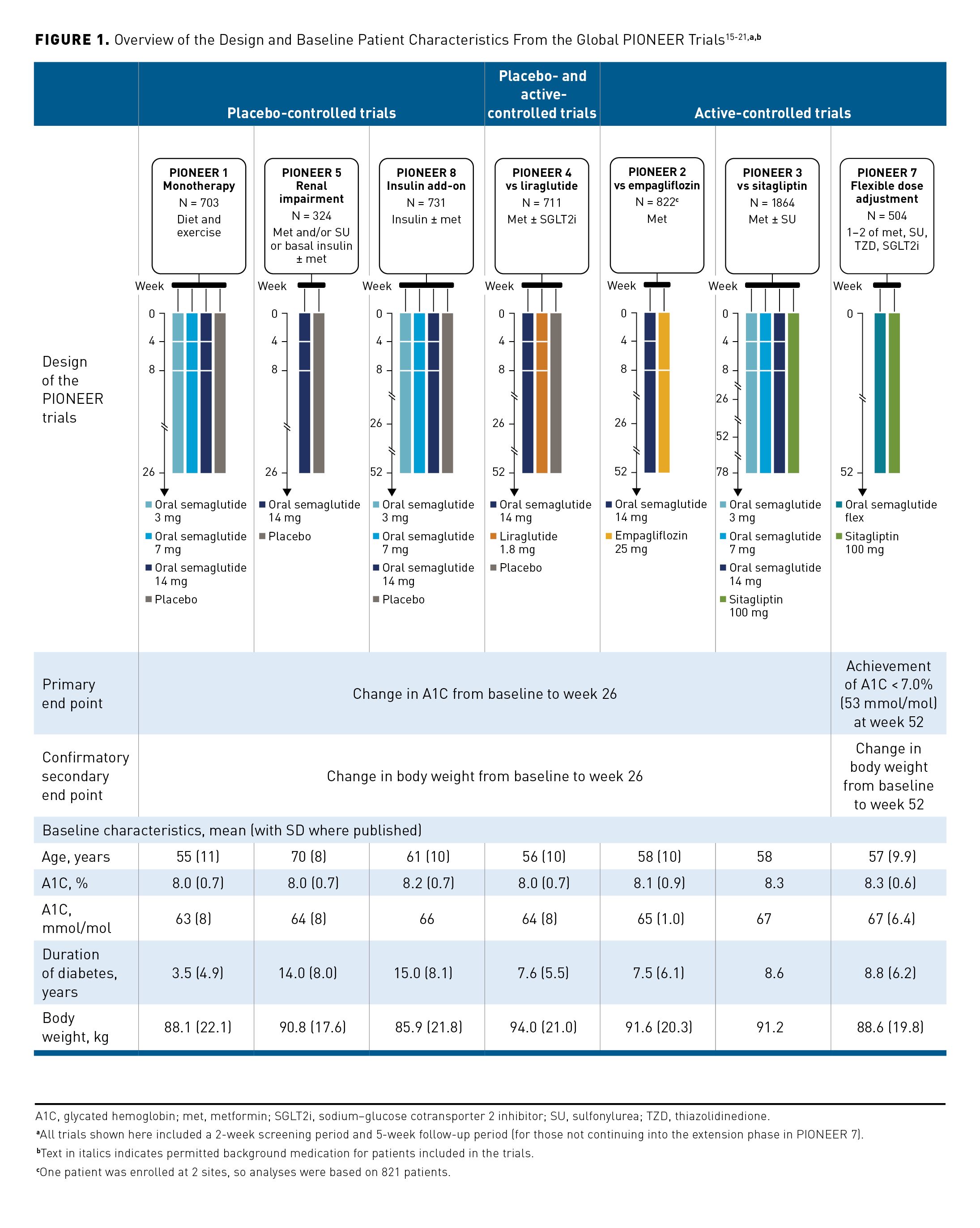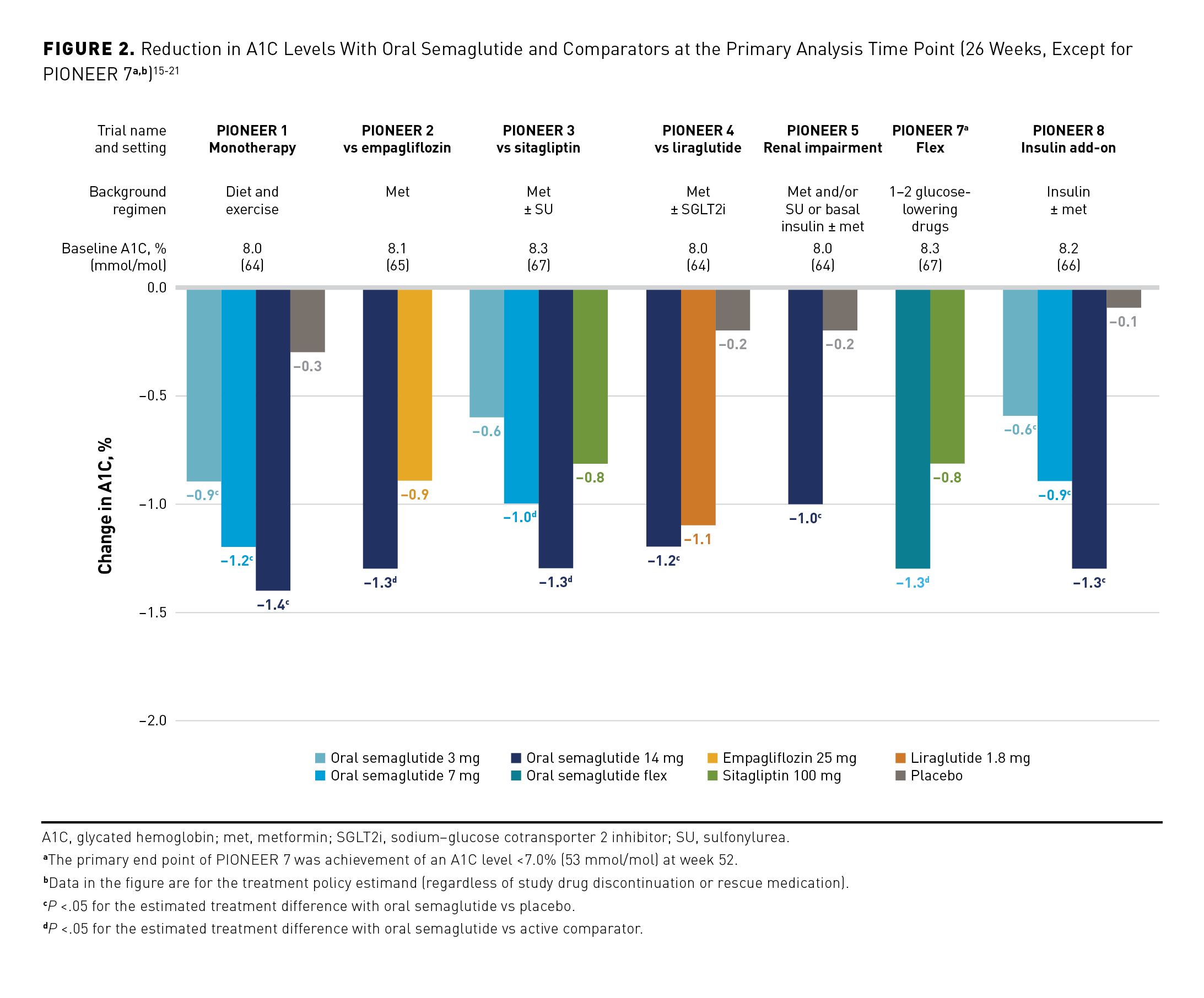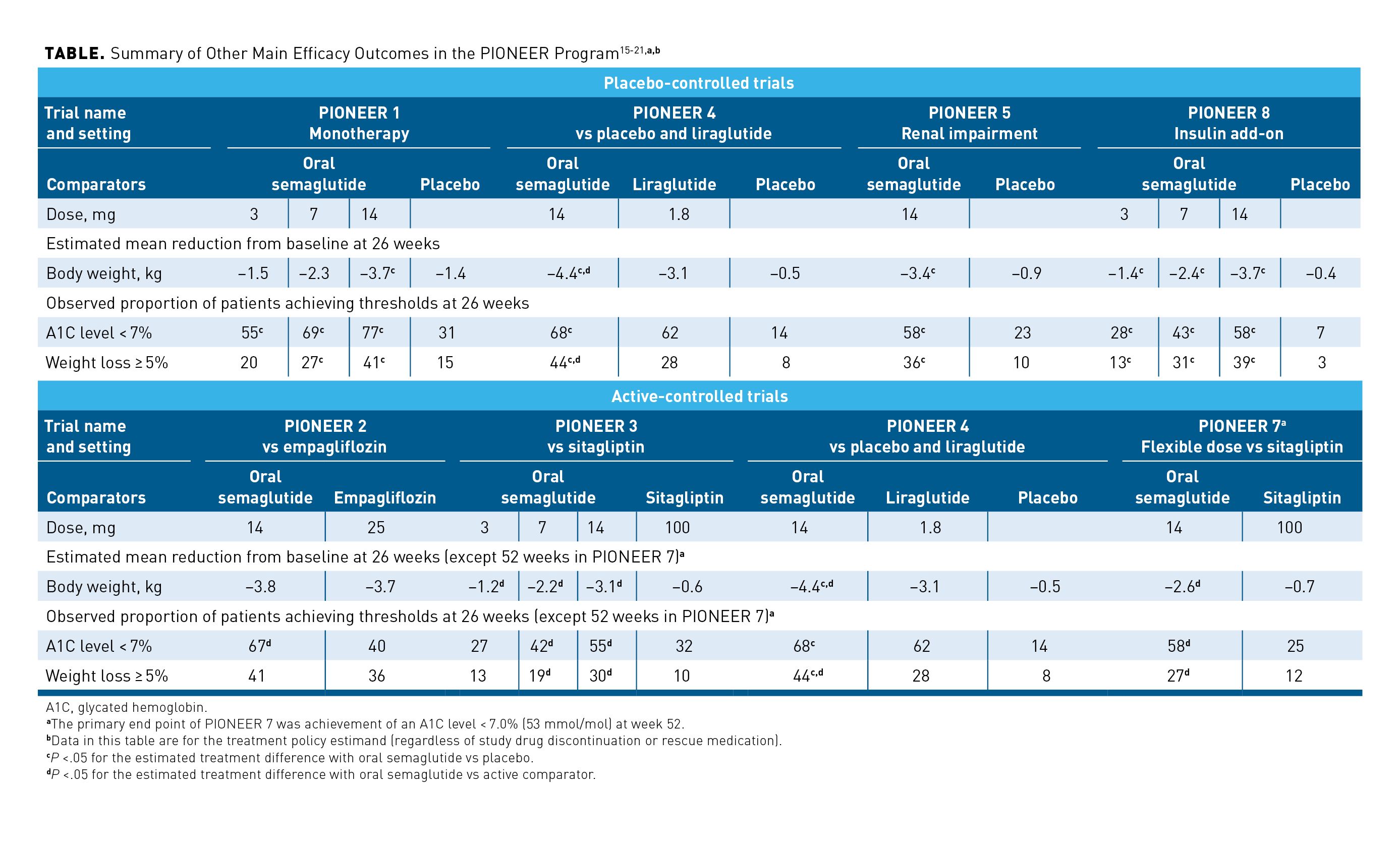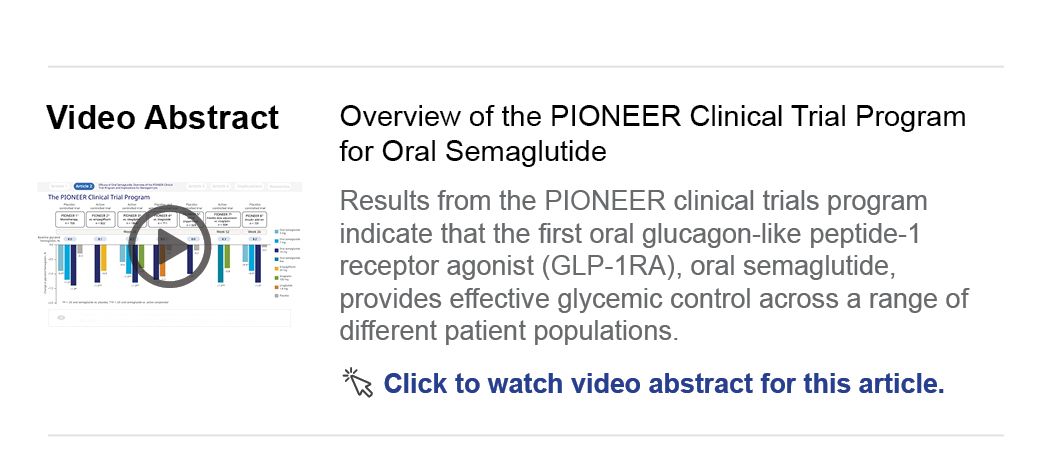- Center on Health Equity & Access
- Clinical
- Health Care Cost
- Health Care Delivery
- Insurance
- Policy
- Technology
- Value-Based Care
Efficacy of Oral Semaglutide: Overview of the PIONEER Clinical Trial Program and Implications for Managed Care
Abstract
The first tablet formulation of a glucagon-like peptide-1 receptor agonist(GLP-1RA), oral semaglutide, was approved in September 2019 for thetreatment of adults with type 2 diabetes (T2D). This article reviews datafrom the PIONEER phase 3a clinical trial program, which assessed theefficacy and safety of oral semaglutide in more than 9500 patients atdifferent stages on the disease trajectory (mean diabetes duration,3.5-15 years) and on a range of background treatment regimens(monotherapy, added to 1 or 2 oral glucose-lowering agents, or added toinsulin). The studies compared oral semaglutide (doses of 3 mg, 7 mg, or14 mg) with placebo, and selected commonly used glucose-loweringagents (empagliflozin 25 mg, sitagliptin 100 mg, or liraglutide 1.8mg). Across the studies, oral semaglutide provided greater glycatedhemoglobin (A1C) reductions than placebo, empagliflozin, or sitagliptinat 26 weeks, and similar A1C reductions as liraglutide. The proportion ofpatients achieving the A1C level recommended by the American DiabetesAssociation of less than 7.0% (53 mmol/mol) was greater with oralsemaglutide (7 mg, 42%-69%; 14 mg, 55%-77%) than placebo (7%-31%)and active comparators (25%-62%), with durable target achievement.Oral semaglutide was associated with similar reductions in body weightas empagliflozin and greater reductions than placebo, sitagliptin, orliraglutide. Oral semaglutide was also efficacious in patients with T2Dand moderate renal impairment. These findings indicate that oralsemaglutide presents a valuable option for treating patients with T2D in amanaged care setting, with the potential to expand the number of patientsbenefiting from GLP‑1RAs.
Am J Manag Care. 2020;26:S335-S343. https://doi.org/10.37765/ajmc.2020.88554
For author information and disclosures, see end of text.
Current Use of Glucagon-like Peptide-1 Receptor Agonists
Glucagon-like peptide-1 receptor agonists (GLP-1RAs) are a well-established treatment for type 2 diabetes (T2D), offering effective glycemic control, weight loss, and a low risk of hypoglycemia.1 Both the American Diabetes Association (ADA) Standards of Medical Care in Diabetes and the American Association of Clinical Endocrinologists/American College of Endocrinology (AACE/ACE) consensus statement recommend a GLP-1RA or a sodium–glucose cotransporter 2 inhibitor (SGLT2i) over alternative options such as a dipeptidyl peptidase-4 inhibitor (DPP-4i), a thiazolidinedione (TZD), or a sulfonylurea (SU) for the second-line treatment of patients with inadequate glycemic control on metformin, with the AACE/ACE consensus statement indicating preference for a GLP-1RA over an SGLT2i.2,3 In addition, the AACE/ACE consensus statement advocates a GLP-1RA or an SGLT2i as the preferred first-line treatment option for patients with, or at high risk of, atherosclerotic cardiovascular disease (CVD), chronic kidney disease, or heart failure.3
Over the last 10 to 15 years, GLP-1RAs have become well established as an efficacious treatment option for patients with T2D, and provide both effective glycemic control and weight loss, but also have a well-characterized safety profile. Until September 2019, GLP‑1RAs were only available for administration by subcutaneous injection twice daily (exenatide4), once daily (lixisenatide5 and liraglutide6), or once weekly (semaglutide,7 dulaglutide,8 and exenatide extended-release9). However, in US analyses of claims data, only 5.4% of adult patients with T2D without CVD, and 4.1% with T2D and established CVD, were prescribed a GLP-1RA.10 The authors suggested a possible reason was that some patients experienced challenges in attaining newer classes of antidiabetic therapies, for example, due to medication cost and high-deductible health care plans. The low rates of GLP-1RA utilization may also be in part because, until recently, all GLP-1RAs were administered by subcutaneous injection, a route that may be less preferable to some patients compared with oral administration.2,11 As such, an oral GLP-1RA could potentially aid initiation of this class of drug earlier in the diabetes treatment trajectory.
Oral semaglutide, the first GLP-1RA developed as a tablet, was approved by the FDA in September 2019 to improve glycemic control in adults with T2D,12 and has since received approval in the European Union, United Kingdom, and Japan.13,14 This article describes the PIONEER phase 3a clinical trial program, which generated data on oral semaglutide in over 9500 patients with T2D in a range of clinical settings, with a focus on the efficacy results and their implications for managed care specialists.
Overview of the PIONEER Clinical Trial Program
The comprehensive global PIONEER program included patients who were representative of those typically encountered in clinical practice (Figure 1).15-21 Common inclusion criteria for the PIONEER trials were at least 18 years old, a diagnosis of T2D at least 90 days prior to screening, and inadequate glycemic control, with an A1C level within the range of 7.0% to 9.5% (53-80 mmol/mol),15-18 7.0% to 10.5% (53-91 mmol/mol),19,20 or 7.5% to 9.5% (58-80 mmol/mol),21 depending on the trial. The various trials assessed the effects of oral semaglutide 3, 7, and 14 mg in patients across the wide spectrum of the T2D disease course. Oral semaglutide was initiated at a dose of 3 mg for all patients, before escalating to 7 mg after 4 weeks, and then to 14 mg after a further 4 weeks depending on the treatment arm.15-20 PIONEER 7 was an exception: patients were initiated at a 3-mg dose and after 8-week intervals the dose could then be increased or decreased, as described earlier.21 Patients with early T2D (mean diabetes duration, 3.5 years) managed on diet and exercise only were studied in PIONEER 1.15 Effects in patients with more established T2D (mean diabetes duration, 7.4 years) already receiving 1 or 2 oral glucose-lowering agents were studied in: PIONEER 2 (metformin only); PIONEER 3 (metformin ± SU); PIONEER 4 (metformin ± SGLT2i); and PIONEER 7 (1 or 2 oral agents including metformin, SU, TZD, or SGLT2i).16,19-21 Patients with advanced disease (mean diabetes duration, 15.0 years) taking insulin (basal, basal-bolus, or premixed; with or without metformin) who required additional treatment were studied in PIONEER 8.18 Further studies were conducted in the settings of renal impairment (PIONEER 5),17 and CVD (PIONEER 6).22

Four trials compared oral semaglutide with commonly used glucose-lowering agents from drug classes recommended for patients who require further treatment intensification, namely, the SGLT2i, empagliflozin (PIONEER 2), the DPP-4i, sitagliptin (PIONEER 3 and 7), and the once-daily injectable GLP-1RA, liraglutide (PIONEER 4).16,19-21
The PIONEER 7 trial assessed the efficacy and safety of oral semaglutide, administered according to an individualized and flexible dose-adjustment approach, compared with a fixed dose of sitagliptin (100 mg) for 52 weeks.21 Rather than the fixed-dose schedule used in the other PIONEER trials (after initial dose escalation), flexible dose adjustment was utilized, designed to mimic the individualized approach used in clinical practice, whereby the dose was increased or decreased depending on the patient’s glycemic response and gastrointestinal tolerability.
Oral semaglutide was also evaluated in specific patient populations. Renal function is a consideration when choosing an additional glucose-lowering treatment. For example, renal excretion of DPP-4is (except linagliptin) necessitates dose adjustment in patients with renal dysfunction.3 In a pharmacokinetic study of oral semaglutide in patients with renal impairment, including end-stage renal disease, no clinically relevant change in semaglutide exposure was observed; therefore, no dose adjustment is recommended.12,23 The PIONEER 5 trial was conducted to explore the efficacy and safety of oral semaglutide 14 mg versus placebo in patients with T2D and moderate renal impairment (estimated glomerular filtration rate [eGFR], 30-59 mL/min/1.73 m²).17 In this trial, 60% of patients had an eGFR of 45 to less than 60 mL/min/1.73 m² and 40% had an eGFR of 30 to less than 45 mL/min/1.73 m²,17 whereas mean eGFR was at least 95 mL/min/1.73 m² in the PIONEER 1 to 4 and 7 trials,15,16,19-21 and 92 mL/min/1.73 m² in PIONEER 8.18 Atherosclerotic CVD (coronary heart disease, cerebrovascular disease, or peripheral arterial disease) is the leading cause of morbidity and death in patients with T2D, resulting in an annual cardiovascular (CV)-related expenditure of $37.3 billion associated with diabetes.24 The CV outcomes trial, PIONEER 6, assessed the effects of oral semaglutide versus placebo in patients with T2D at high risk of CV events,22 and is discussed in a separate article.25
Oral semaglutide was initiated at a dose of 3 mg for all patients, before escalating to 7 mg after 4 weeks, and then to 14 mg after a further 4 weeks depending on the treatment arm.15-20 PIONEER 7 was an exception: patients were initiated at a 3-mg dose and after 8-week intervals the dose could then be increased or decreased, as described earlier.21 Patients were instructed to take oral semaglutide once daily in the morning on an empty stomach, with no more than 4 fl oz (120 mL) water, and to wait 30 minutes before consuming any food, further fluids, or any other oral medication.15-21 This is because a shorter delay may decrease semaglutide absorption.12
The primary and confirmatory secondary end points in most PIONEER trials were change from baseline in A1C level and body weight, respectively, at week 26 (Figure 115-21). An exception was PIONEER 7, in which the primary end point was the proportion of patients achieving the ADA-recommended target of an A1C level less than 7.0% (53 mmol/mol) at week 52.21 A1C and body weight outcomes were not evaluated for statistical difference to placebo in PIONEER 6,22 so results are not discussed herein.
How Does the Phase 3a Program of Oral Semaglutide Compare With That of Injectable Semaglutide?
Injectable once-weekly semaglutide was first approved by the FDA in 2017 to improve glycemic control in T2D,7 based on results from the SUSTAIN phase 3a clinical trial program. The global phase 3a program for injectable semaglutide was conducted in 7215 participants across 6 trials: SUSTAIN 1, 4, and 5 for 30 weeks; SUSTAIN 2 and 3 for 56 weeks; and SUSTAIN 6 for 104 weeks.26-31 Following completion of the SUSTAIN 1 through SUSTAIN 6 trials, results from 4 phase 3b trials with injectable semaglutide (N = 2868; SUSTAIN 7-10) were published.32-35
Across the 6 SUSTAIN phase 3a trials, 2 doses of injectable semaglutide were evaluated (0.5 mg and 1.0 mg), except in SUSTAIN 3, where only semaglutide 1.0 mg was evaluated.26‑31 Once-weekly injectable semaglutide was compared with placebo (SUSTAIN 1, 5, and 6) and the active comparators, sitagliptin (SUSTAIN 2), exenatide extended-release (SUSTAIN 3), and insulin glargine (SUSTAIN 4).
Similar to the PIONEER trials, the primary and confirmatory secondary end points of SUSTAIN 1 through SUSTAIN 5 were change from baseline in A1C level and body weight, respectively; unlike in PIONEER, the main efficacy outcomes were evaluated at the end of treatment (30 or 56 weeks).26-30 As with PIONEER, there was a dedicated CV outcomes trial, SUSTAIN 6, to assess the effects of injectable semaglutide versus placebo, for 104 weeks, in patients with T2D at high risk of CV events.31 Although patients with renal impairment were included in this trial, this patient population was not assessed in a separate phase 3 trial of injectable semaglutide.
Efficacy and safety results from the phase 3 SUSTAIN program showed that once-weekly injectable semaglutide provided a highly efficacious treatment option for patients with T2D. Patients receiving semaglutide experienced consistently reduced A1C levels, greater body weight loss versus comparators, and benefited from a low risk of hypoglycemia and a similar overall safety profile with the GLP-1RA class.
Efficacy of Oral Semaglutide in the PIONEER Trials
The following key efficacy data are for the treatment policy estimand, which assessed the treatment effect for all patients randomized regardless of treatment discontinuation or use of rescue medication (patients receiving additional glucose-lowering medication initiated during the trial), and reflects the intention-to-treat principle.15-21 In the placebo-controlled PIONEER 1 and PIONEER 8 studies, oral semaglutide 3 mg showed superior reductions in A1C levels (–0.6% to –0.9%) and body weight (–1.4 kg to –1.5 kg), and a significantly greater proportion of patients achieved an A1C level less than 7.0% versus placebo (P < .0001).15,18 However, the 3-mg dose is intended for treatment initiation only, and the remainder of this section will focus on semaglutide 7 mg and 14 mg, which will be predominately utilized in clinical practice as the indicated doses used to maintain glycemic control.12
Glycemic Control
Results for A1C reductions from baseline in placebo- and active-controlled trials are shown in Figure 2.15-21 In the PIONEER 1 trial, once-daily oral semaglutide monotherapy at 7 mg and 14 mg demonstrated superior improvements in A1C versus placebo at 26 weeks in patients with T2D insufficiently controlled with diet and exercise (estimated treatment difference [ETD]: –0.9% [7 mg], –1.1% [14 mg]; P < .001 for both).15 Similar findings were reported in PIONEER 4.16 In patients with uncontrolled T2D taking metformin with or without an SGLT2i, oral semaglutide 14 mg was superior to placebo in decreasing A1C levels at 26 weeks (ETD, –1.1%; P < .0001).16 In this trial, comparisons were also made to the injectable GLP-1RA, liraglutide. A1C reductions were similar with oral semaglutide 14 mg and injectable liraglutide 1.8 mg at 26 weeks (ETD, –0.1%; P = .0645).

In PIONEER 2, oral semaglutide 14 mg was superior to empagliflozin 25 mg at reducing A1C levels at 26 weeks (ETD, –0.4%; P < .0001) when used as second-line treatment in patients with uncontrolled T2D taking metformin.19 Oral semaglutide 7 mg and 14 mg also provided superior improvements in A1C levels versus sitagliptin 100 mg at 26 weeks in PIONEER 3 (ETD, –0.3% [7 mg], –0.5% [14 mg]; P < .001 for both), which included patients with uncontrolled T2D on metformin with or without an SU.20 The glucose-lowering effect of oral semaglutide was sustained with the 14-mg dose, and at 78 weeks, the ETDs for change from baseline in A1C level were –0.1% and –0.4% for oral semaglutide 7 mg and 14 mg, respectively, versus sitagliptin 100 mg (P = .06 [7 mg]; P < .001 [14 mg]).20
PIONEER 5 included patients with moderate renal impairment on a range of different background medications, including insulin, and had an older study population compared with other trials (Figure 115-21).17 Oral semaglutide 14 mg was significantly more effective than placebo in reducing A1C levels at week 26 (ETD, –0.8%; P <.0001). The overall safety profile, including renal safety, was consistent with other GLP-1RAs, as discussed in the article on the safety of oral semaglutide.25
Across the PIONEER studies, the proportion of patients achieving the ADA-recommended target of an A1C level less than 7.0% (53 mmol/mol) was consistently greater with oral semaglutide 7 mg (42%-69%) and 14 mg (55%-77%) than with placebo (7%-31%), and with active comparators, liraglutide 1.8 mg (62%), empagliflozin 25 mg (40%), and sitagliptin 100 mg (32%) (Table).15-21 This advantage was generally maintained or improved at the end of the trial (52 or 78 weeks).15-21 In PIONEER 7, where target achievement at week 52 was the primary end point, the proportion of patients with an A1C level less than 7.0% (53 mmol/mol) was more than twice as high with flexibly dosed oral semaglutide than with sitagliptin (58% vs 25%, respectively).21 This was despite 4 times as many patients in the sitagliptin group receiving rescue medication versus oral semaglutide (15.9% vs 3.2%, respectively) up to week 52.

Using data from the SUSTAIN and PIONEER trials, population pharmacokinetic and exposure–response analyses were used to investigate if the oral route of administration impacted the efficacy and tolerability of semaglutide when compared with injectable administration.36 Although there was more variability in plasma concentrations for oral semaglutide than for the injectable formulation, there was overlap of the exposure ranges between the oral semaglutide 7 mg and 14 mg doses and the injectable semaglutide 0.5 mg and 1.0 mg doses. In addition, the results showed that the exposure–response relationships for efficacy and tolerability were similar, regardless of whether semaglutide was administered via injection or tablet.
Body Weight Reductions
Oral semaglutide was effective in reducing body weight across the continuum of T2D and with different background glucose-lowering medications (Table).15-21 Oral semaglutide 7 mg and 14 mg given as monotherapy reduced body weight versus placebo at 26 weeks in patients with early T2D managed with diet and exercise (ETD, –0.9 kg [7 mg] to –2.3 kg [14 mg]), with reductions reaching significance for the 14-mg dose (P < .001).15 Against the GLP-1RA, liraglutide 1.8 mg, oral semaglutide 14 mg provided a greater body weight reduction at week 26 (ETD, –1.2 kg; P = .0003), and this reduction was sustained to 52 weeks (ETD, –1.3 kg; P = .0019).16
In patients receiving background metformin in PIONEER 2, oral semaglutide 14 mg reduced body weight by 3.8 kg at 26 weeks, similar to the 3.7-kg reduction seen with empagliflozin 25 mg.19 Compared with sitagliptin 100 mg, oral semaglutide was associated with significantly greater reductions in body weight with the 7-mg and 14-mg doses at week 26 in PIONEER 3 (ETD, –1.6 kg [7 mg], –2.5 kg [14 mg]; P < .001 for both),20 and when flexibly dosed for 52 weeks in PIONEER 7 (ETD, –1.9 kg; P < .0001).21
In patients with more advanced T2D receiving background insulin in PIONEER 8, patients receiving oral semaglutide 7 mg and 14 mg experienced significant reductions in body weight versus placebo at 26 weeks (ETD, –2.0 kg; P = .0001 [7 mg]; ETD, –3.3 kg; P < .0001 [14 mg]).18 In light of this, the authors suggested that oral semaglutide may help overcome some of the adverse effects associated with insulin use, such as weight gain, which may contribute to therapeutic inertia in the initiation or intensification of an insulin regimen.18 Oral semaglutide 14 mg also significantly reduced body weight versus placebo in patients with moderate renal impairment at 26 weeks (ETD, –2.5 kg; P < .0001).17
The proportion of patients achieving a weight loss of at least 5% was greater with oral semaglutide 7 mg (19%-27%) and 14 mg (30%-44%) versus placebo (3%-15%), and was greater with oral semaglutide 14 mg than the active comparators liraglutide 1.8 mg (28%), empagliflozin 25 mg (36%), and sitagliptin 100 mg (10%) (Table).15-21
Implications for Managed Care
Effective glycemic control has been associated with improved diabetes-related outcomes and reduced risk or delay of debilitating and costly complications.37,38 Studies have also shown improved glycemic control to be associated with lower health care costs. A collaborative endocrinologist-pharmacist diabetes intense medical management approach demonstrated greater A1C reductions versus usual primary care physician management (-2.4% vs -0.8% at 6 months; P < .001). Using data from April 2009 to November 2013, the estimated mean 3-year cost difference per patient due to improved A1C levels, from a health system perspective, was $8793 with diabetes intense medical management versus $3506 with a primary care physician.37 In addition, a separate study determined that decreases in A1C levels versus no change were associated with 24% ($2503) and 17% ($1690) lower average annual health care costs during the first and second year follow-ups, respectively.38
The PIONEER program established oral semaglutide as providing effective glycemic control across a range of different patient populations receiving different background medications at different stages of the disease trajectory. With oral semaglutide 14 mg, the magnitude of A1C reductions (1.0%-1.3%) and the proportion of patients achieving an A1C level less than 7% (55%-77%) were similar to injectable liraglutide, and higher than empagliflozin and sitagliptin at 26 weeks.16,19-21 Furthermore, data indicate that the glucose-lowering effect of oral semaglutide was sustained up to 52 weeks (PIONEER 2, 3, and 7),16,19,21 and 78 weeks (PIONEER 3).20 Considering these results, oral semaglutide offers an efficacious treatment option, with comparable outcomes to injectable GLP-1RAs, that can be taken in tablet form. Thus, oral semaglutide enables potentially greater accessibility to a larger number of patients across the diabetes treatment continuum. An evaluation of the cost per patient achieving treatment targets with oral semaglutide was conducted across the active comparator PIONEER trials.39 Oral semaglutide was consistently associated with a lower annual cost of control versus active comparators (liraglutide 1.8 mg, empagliflozin 25 mg, and sitagliptin 100 mg) when analyzing 4 different end points (A1C level ≤ 6.5%: $6996-$15,036 lower cost; A1C level < 7%: $346-$4497 lower cost; ≥ 1.0%-point A1C reduction and weight loss ≥ 3.0%: $525-$32,277 lower cost; and A1C level < 7.0% without hypoglycemia and without weight gain: $1255-$7510 lower cost).39
Some treatments for T2D are associated with weight gain (eg, TZDs, insulin, and SUs) or are weight neutral (eg, DPP-4is), whereas GLP-1RAs and SGLT2is are associated with weight loss.2,3 In the PIONEER trials, oral semaglutide 14 mg was associated with greater weight loss than sitagliptin and liraglutide, and equivalent weight loss to empagliflozin at week 26, with reductions up to 4.4 kg, depending on the study.16,19-21 Therefore, oral semaglutide can offer multidimensional benefits to patients, such as aiding weight loss while still providing effective glycemic control. The ADA glycemic treatment guidelines recommend a preference for therapies offering weight loss, such as GLP-1RAs,2 and weight loss in patients with T2D could also decrease their risk of developing comorbidities, such as CVD, and reduce the annual associated cost implications.23
Given the prominent position of GLP-1RAs in the treatment of T2D according to US recommendations, the availability of oral semaglutide may open up the GLP-1RA class for patients and prescribers with a preference for oral versus injectable therapy, and may lead to their earlier use in the diabetes treatment trajectory.
Acknowledgments
This article was supported by Novo Nordisk Inc; the company was provided with the opportunity to perform a medical accuracy review. Under the direction of the authors, medical writing and editorial support was provided by Nicole Cash of Axis, a division of Spirit Medical Communications Group Limited (funded by Novo Nordisk Inc).
Author affiliations: Endocrine and Metabolic Consultants (HWR); Jefferson Health (TD); WellDyne (PTA).
Funding source: Financial support for this work was provided by Novo Nordisk Inc.
Author disclosures: Dr Rodbard reports that she has received grant support and consultant fees from AstraZeneca, Boehringer Ingelheim, Janssen, Lexicon, Lilly, Novo Nordisk Inc, and Sanofi, and is an advisory board member and received consultant fees from Merck. Dr Dougherty has no relevant financial relationships with commercial interests to disclose. Dr Taddei-Allen reports that she is an advisory board member for Novo Nordisk Inc.
Authorship information: Drafting the manuscript (HWR, TD, PTA); critical revision of the manuscript for important intellectual content (HWR, TD, PTA); responsibility for content (HWR, TD, PTA).
Address correspondence to: Helena W. Rodbard, MD, 3200 Tower Oaks Blvd, Suite 250, Rockville, MD 20852. Email: hrodbard@comcast.net. Phone: +1 301 770 7373. Fax: +1 301 770 7272.
References
1. Handelsman Y, Wyne K, Cannon A, et al. Glycemic efficacy, weight effects, and safety of once-weekly glucagon-like peptide-1 receptor agonists. J Manag Care Spec Pharm. 2018;24(suppl 9-a):S14-S29. doi:10.18553/jmcp.2018.24.9-a.s14. Published correction appears in J Manag Care Spec Pharm. 2018 Nov;24(11):1196a.
2. American Diabetes Association. 9. Pharmacologic approaches to glycemic treatment: Standards of Medical Care in Diabetes-2020. Diabetes Care. 2020;43(suppl 1):S98-S110. doi:10.2337/dc20-S009
3. Garber AJ, Handelsman Y, Grunberger G, et al. Consensus statement by the American Association of Clinical Endocrinologists and American College of Endocrinology on the comprehensive type 2 diabetes management algorithm – 2020 Executive Summary. Endocr Pract. 2020;26(1):107-139. doi:10.4158/CS-2019-0472
4. Byetta. Prescribing information. AstraZeneca Pharmaceuticals LP; 2020. Accessed April 13, 2020. https://www.drugs.com/pro/byetta.html
5. Adlyxin. Prescribing information. Sanofi-Aventis US LLC; 2019. Accessed April 13, 2020. https://www.drugs.com/pro/adlyxin.html
6. Victoza. Prescribing information. Novo Nordisk Inc; 2019. Accessed April 13, 2020. https://www.drugs.com/pro/victoza.html
7. Ozempic. Prescribing information. Novo Nordisk Inc; 2020. Accessed April 1, 2020. https://www.drugs.com/pro/ozempic.html
8. Trulicity. Prescribing information. Eli Lilly & Co; 2020. Accessed April 13, 2020. https://www.drugs.com/pro/trulicity.html
9. Bydureon. Prescribing information. AstraZeneca Pharmaceuticals LP; 2020. Accessed April 13, 2020. https://www.drugs.com/pro/bydureon.html
10. Pantalone KM, Misra-Hebert AD, Hobbs TM, et al. Antidiabetic treatment patterns and specialty care utilization among patients with type 2 diabetes and cardiovascular disease. Cardiovasc Diabetol. 2018;17(1):54. doi:10.1186/s12933-018-0699-7
11. Polonsky WH, Henry RR. Poor medication adherence in type 2 diabetes: recognizing the scope of the problem and its key contributors. Patient Prefer Adherence. 2016;10:1299-1307. doi:10.2147/PPA.S106821
10. Pantalone KM, Misra-Hebert AD, Hobbs TM, et al. Antidiabetic treatment patterns and specialty care utilization among patients with type 2 diabetes and cardiovascular disease. Cardiovasc Diabetol. 2018;17(1):54. doi:10.1186/s12933-018-0699-7
11. Polonsky WH, Henry RR. Poor medication adherence in type 2 diabetes: recognizing the scope of the problem and its key contributors. Patient Prefer Adherence. 2016;10:1299-1307. doi:10.2147/PPA.S106821
12. Rybelsus. Prescribing information. Novo Nordisk Inc; 2020. Accessed April 20, 2020. https://www.accessdata.fda.gov/drugsatfda_docs/label/2020/209637s003lbl.pdf
13. Rybelsus. Annex I: summary of product characteristics. Novo Nordisk Inc; 2020. Accessed June 11, 2020. https://www.ema.europa.eu/en/documents/product-information/rybelsus-epar-product-information_en.pdf
14. Rybelsus approved in Japan for the treatment of type 2 diabetes. Company announcement. Novo Nordisk Inc. June 29, 2020. Accessed July 22, 2020. https://ml-eu.globenewswire.com/Resource/Download/46a404a8-4e2b-41d5-a5fa-fa36cfae964f
15. Aroda VR, Rosenstock J, Terauchi Y, et al; PIONEER 1 Investigators. PIONEER 1: randomized clinical trial of the efficacy and safety of oral semaglutide monotherapy in comparison with placebo in patients with type 2 diabetes. Diabetes Care. 2019;42(9):1724-1732. doi:10.2337/dc19-074915
16. Pratley R, Amod A, Hoff ST, et al; PIONEER 4 investigators. Oral semaglutide versus subcutaneous liraglutide and placebo in type 2 diabetes (PIONEER 4): a randomised, double-blind, phase 3a trial. Lancet. 2019;394(10192):39-50. doi:10.1016/S0140-6736(19)31271-1
17. Mosenzon O, Blicher TM, Rosenlund S, et al; PIONEER 5 Investigators. Efficacy and safety of oral semaglutide in patients with type 2 diabetes and moderate renal impairment (PIONEER 5): a placebo-controlled, randomised, phase 3a trial. Lancet Diabetes Endocrinol. 2019;7(7):515-527. doi:10.1016/S2213-8587(19)30192-5
18. Zinman B, Aroda VR, Buse JB, et al; PIONEER 8 Investigators. Efficacy, safety, and tolerability of oral semaglutide versus placebo added to insulin with or without metformin in patients with type 2 diabetes: The PIONEER 8 trial. Diabetes Care. 2019;42(12):2262-2271. doi:10.2337/dc19-0898
19. Rodbard HW, Rosenstock J, Canani LH, et al; PIONEER 2 Investigators. Oral semaglutide versus empagliflozin in patients with type 2 diabetes uncontrolled on metformin: the PIONEER 2 trial. Diabetes Care. 2019;42(12):2272-2281.
20. Rosenstock J, Allison D, Birkenfeld AL, et al; PIONEER 3 Investigators. Effect of additional oral semaglutide vs sitagliptin on glycated hemoglobin in adults with type 2 diabetes uncontrolled with metformin alone or with sulfonylurea: The PIONEER 3 randomized clinical trial. JAMA. 2019;321(15):1466-1480. doi:10.1001/jama.2019.2942
21. Pieber TR, Bode B, Mertens A, et al; PIONEER 7 investigators. Efficacy and safety of oral semaglutide with flexible dose adjustment versus sitagliptin in type 2 diabetes (PIONEER 7): a multicentre, open-label, randomised, phase 3a trial. Lancet Diabetes Endocrinol. 2019;7(7):528-539. doi:10.1016/S2213-8587(19)30194-9
22. Husain M, Birkenfeld AL, Donsmark M, et al; PIONEER 6 Investigators. Oral semaglutide and cardiovascular outcomes in patients with type 2 diabetes. N Engl J Med. 2019;381(9):841-851. doi:10.1056/NEJMoa1901118
23. Baekdal TA, Thomsen M, Kupcová V, et al. Pharmacokinetics, safety, and tolerability of oral semaglutide in subjects with hepatic impairment. J Clin Pharmacol. 2018;58(10):1314-1323. doi:10.1002/jcph.1131
24. American Diabetes Association. 10. Cardiovascular disease and risk management: Standards of Medical Care in Diabetes-2020. Diabetes Care. 2020;43(suppl 1):S111-S134. doi:10.2337/dc20-S010
25. Lingvay I, Taddei-Allen P, Dougherty T. Cardiovascular outcomes, safety, and tolerability with oral semaglutide: insights for managed care. Am J Manag Care. 2020;26(suppl 16):S344-S355. doi:10.37765/ajmc.2020.88555
26. Sorli C, Harashima SI, Tsoukas GM, et al. Efficacy and safety of once-weekly semaglutide monotherapy versus placebo in patients with type 2 diabetes (SUSTAIN 1): a double-blind, randomised, placebo-controlled, parallel-group, multinational, multicentre phase 3a trial. Lancet Diabetes Endocrinol. 2017;5(4):251-260. doi:10.1016/S2213-8587(17)30013-X
27. Ahrén B, Masmiquel L, Kumar H, et al. Efficacy and safety of once-weekly semaglutide versus once-daily sitagliptin as an add-on to metformin, thiazolidinediones, or both, in patients with type 2 diabetes (SUSTAIN 2): a 56-week, double-blind, phase 3a, randomised trial. Lancet Diabetes Endocrinol. 2017;5(5):341-354. doi:10.1016/S2213-8587(17)30092-X
28. Ahmann AJ, Capehorn M, Charpentier G, et al. Efficacy and safety of once-weekly semaglutide versus exenatide ER in subjects with type 2 diabetes (SUSTAIN 3): a 56-week, open-label, randomized clinical trial. Diabetes Care. 2018;41(2):258-266. doi:10.2337/dc17-0417
29. Aroda VR, Bain SC, Cariou B, et al. Efficacy and safety of once-weekly semaglutide versus once-daily insulin glargine as add-on to metformin (with or without sulfonylureas) in insulin-naive patients with type 2 diabetes (SUSTAIN 4): a randomised, open-label, parallel-group, multicentre, multinational, phase 3a trial. Lancet Diabetes Endocrinol. 2017;5(5):355-366. doi:10.1016/S2213-8587(17)30085-2
30. Rodbard HW, Lingvay I, Reed J, et al. Semaglutide added to basal insulin in type 2 diabetes (SUSTAIN 5): a randomized, controlled trial. J Clin Endocrinol Metab. 2018;103(6):2291-2301. doi:10.1210/jc.2018-00070
31. Marso SP, Bain SC, Consoli A, et al; SUSTAIN-6 investigators. Semaglutide and cardiovascular outcomes in patients with type 2 diabetes. N Engl J Med. 2016;375(19):1834-1844. doi:10.1056/NEJMoa1607141
32. Pratley RE, Aroda VR, Lingvay I, et al; SUSTAIN 7 investigators. Semaglutide versus dulaglutide once weekly in patients with type 2 diabetes (SUSTAIN 7): a randomised, open-label, phase 3b trial. Lancet Diabetes Endocrinol. 2018;6(4):275-286. doi:10.1016/S2213-8587(18)30024-X
33. Lingvay I, Catarig AM, Frias JP, et al. Efficacy and safety of once-weekly semaglutide versus daily canagliflozin as add-on to metformin in patients with type 2 diabetes (SUSTAIN 8): a double-blind, phase 3b, randomised controlled trial. Lancet Diabetes Endocrinol. 2019;7(11):834-844. doi:10.1016/S2213-8587(19)30311-0
34. Zinman B, Bhosekar V, Busch R, et al. Semaglutide once weekly as add-on to SGLT-2 inhibitor therapy in type 2 diabetes (SUSTAIN 9): a randomised, placebo-controlled trial. Lancet Diabetes Endocrinol. 2019;7(5):356-367. doi:10.1016/S2213-8587(19)30066-X
35. Capehorn MS, Catarig AM, Furberg JK, et al. Efficacy and safety of once-weekly semaglutide 1.0mg vs once-daily liraglutide 1.2mg as add-on to 1-3 oral antidiabetic drugs in subjects with type 2 diabetes (SUSTAIN 10). Diabetes Metab. 2020;46(2):100-109. doi:10.1016/j.diabet.2019.10111734
36. Overgaard RV, Navarria A, Hertz CL, Ingwersen SH. Similar efficacy and gastrointestinal tolerability versus exposure for oral and subcutaneous semaglutide. Paper presented at: 55th Annual Meeting of the European Association for the Study of Diabetes; September 17–20, 2019; Barcelona, Spain. Accessed September 3, 2020. https://www.novonordiskscientificmaterial.com/assets/easd_777_overgaard.pdf
37. Hirsch JD, Bounthavong M, Arjmand A, et al. Estimated cost-effectiveness, cost benefit, and risk reduction associated with an endocrinologist-pharmacist diabetes intense medical management “tune-up” clinic. J Manag Care Spec Pharm. 2017;23(3):318-326. doi:10.18553/jmcp.2017.23.3.318
38. Bansal M, Shah M, Reilly B, et al. Impact of reducing glycated hemoglobin on healthcare costs among a population with uncontrolled diabetes. Appl Health Econ Health Policy. 2018;16(5):675-684. doi:10.1007/s40258-018-0398-2
39. Hunt B, Hansen BB, Ericsson Å, et al. Evaluation of the cost per patient achieving treatment targets with oral semaglutide: a short-term cost-effectiveness analysis in the United States. Adv Ther. 2019;36(12):3483-3493. doi:10.1007/s12325-019-01125-y


